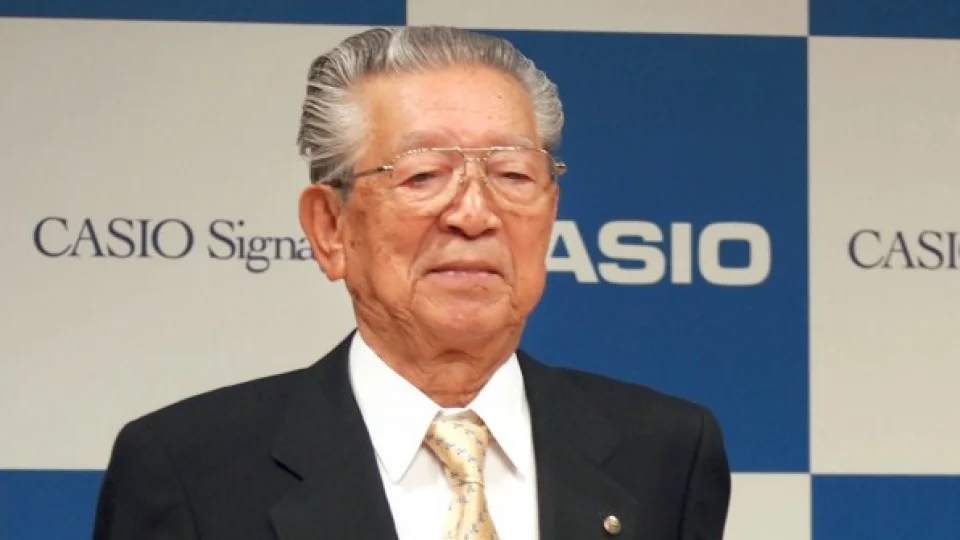1. History and Origins of Casio
Founded in 1946 by Tadao Kashio in Tokyo, Casio began its life as Kashio Seisakujo, a humble workshop crafting innovative tools like the yubiwa pipe—a ring that held a cigarette to smoke it down to the nub. Driven by imagination and necessity, it wasn’t long before Casio engineers turned their inventiveness toward electronics.
By 1957, Casio released the 14-A, the world’s first compact all-electric calculator, and formally became Casio Computer Co., Ltd.. The company rapidly expanded globally, entering the U.S. and European markets in the late 1960s
Casio’s early decades were defined by breakthroughs in digital accuracy and automation. In 1967 they rolled out the AL-1000, the first programmable electronic desktop calculator. Their spirit of innovation continued into other domains with electronic musical instruments and early digital cameras in the subsequent decades.
In sum, Casio’s history is rooted in creative problem-solving, transforming everyday frustration into revolutionary, enduring products.
2. Casio’s Calculator and Databank Innovation
Casio didn’t stop at just calculators. In 1980, they introduced the C-80, the first calculator watch, followed by the Databank series in 1983 (models CD-40 and CD-401)—smartwatches before smartwatches existed.
The Databank series featured data storage, calculators, and even phone dialing abilities; later versions added world time, schedule planners, backlights, touch screens, voice recording, and atomic time syncing. This line was a pioneer in portable electronic personal organization, long before smartphones dominated.
Parallel to these watches, Casio rolled out scientific calculators, such as the fx-39 in 1978 and the world’s first graphing calculator, the FX-7000G, in 1985. These tools revolutionized academic and professional work, delivering complex functionalities at accessible prices.
Through these innovations, Casio carved its legacy as a leader in practical, high-performance electronics.
3. Calculator Watches: Iconic and Retro Appeal
Casio’s calculator watches remain stylistic icons today. The CA-53W, launched in 1988, is perhaps the most famous—featured in Back to the Future Part II & III and Breaking Bad. Lightweight, visual, and instantly recognizable, it’s a symbol of the ’80s yet unaged by time.
These watches are also highly functional. Take the CA-53W-1: built from resin, it’s just 8.2 mm thick and weighs only 24–25 g, offering calculator, stopwatch, dual-time, and alarm features in an ultra-light chassis. The CA-500WE series modernized this nostalgia with metal bands and retro styling while keeping the 8-digit calculator, alarm, stopwatch, and durability intact.
These watches blend function with fashion—they are conversation starters with utility baked in.
4. Modern Casio Watch Collections
Casio’s current offerings go far beyond calculator watches. G-Shock stands out as a symbol of toughness: the original DW-5000C (1983) defined shock-resistant watch design. They continue innovating: for example, the DW-H5600 now includes heart rate and SpO₂ sensors, solar charging, 200 m water resistance, and fitness tracking—while still staying deeply rugged.
The Baby-G line—budget-friendly and playful—also impresses. The BG169R-2C adds joy with animated backlight features, exceptional 3-year battery life, and strong water resistance for under $100.
Other flagship lines include:
-
ProTrek: survival-ready with altimeter and compass
-
Oceanus: tech-luxury hybrids
-
Edifice: motorsport-inspired chronograph style.
Across all these models, Casio emphasizes affordability, durability, and design.
5. Casio’s Legacy in Popular Culture
Casio’s cultural resonance spans decades. The F-91W, introduced in 1989, remains one of the best-selling watches ever—with roughly 3 million units produced annually. Its unassuming design and functionality have earned it cult-status. A writer even mused that they’d rather keep a simple Casio F-91W than switch to a designer watch, praising its lightweight simplicity and reliability.
Casio also celebrates its heritage. In 2024, marking 50 years of watchmaking, they released vintage-inspired lines like the revival Casiotron TRN-50—one of the original LCD models—with modern updates like solar charging and smartphone sync.
They’ve also had fun with innovation: in the early ’80s, Casio released game watches featuring mini video games like Space Invaders and racing games—a quirky intersection of utility and entertainment.
This blend of nostalgia, pop culture presence, and inventive spin-offs keeps Casio timelessly relevant.
6. Why Casio Remains SEO-Worthy and Relevant Today
Casio’s continued popularity is driven by several key factors:
-
Historical depth: A narrative that spans from post-war invention to cutting-edge wearable tech.
-
Iconic models: From the calculator CA-53W to the rugged G-Shock, Casio watches have enduring visibility in entertainment, media, and everyday life.
-
Consistent innovation: Whether it’s early calculator watches, graphing calculators, or modern hybrids with sensors, Casio pushes boundaries while staying true to their core.
-
Affordability and durability: Across all segments, Casio offers reliable, accessible gear—empowering users without breaking the bank.
-
Fashion meets function: Retro designs remain stylish; modern executions blend performance with aesthetics.
-
Cultural resonance: With decades-long relevance, collectors, influencers, and mainstream users alike continue to celebrate Casio.
These factors make Casio a robust SEO topic—combining evergreen history, current innovation, pop culture, and wide audience appeal.
Conclusion
Casio stands as a remarkable story of innovation born from necessity, evolving from a small Tokyo workshop to a global electronics giant. From pioneering calculator watches and personal organizers to redefining ruggedness with G-Shock and now blending nostalgia with modern tech, Casio remains both relevant and iconic. Their mix of utility, longevity, affordability, and cultural flair ensures Casio stays not only searchable but also celebrated.
SEO-Driven FAQs
1. What was Casio’s first calculator watch?
Casio introduced its first calculator watch, the C-80, in 1980 and later launched the Databank models in 1983, combining data storage with classic watch functions
2. Why is the CA-53W calculator watch so famous?
Released in 1988, the CA-53W became a cultural icon, seen in Back to the Future II & III and Breaking Bad, and remains celebrated for its design and utility
3. What makes the F-91W so enduring?
The F-91W, launched in 1989, is loved for its low price, long battery life, durable design, and minimalist aesthetic. It’s one of the world’s best-selling watches, with 3 million units produced annually.
4. How has Casio evolved in modern times?
Today, Casio continues pushing tech boundaries with lines like G-Shock Move (heart rate, SpO₂, solar charging), Baby-G, ProTrek, Edifice, and more—delivering rugged, stylish, and functional watches at approachable prices
5. Why do people still love Casio watches?
Casio’s enduring appeal lies in its blend of reliability, affordability, innovative feature sets, retro-chic design, and rich history—spanning collectors, everyday users, and cultural enthusiasts alike.




